Business Law: Legal Systems, Legislation, Solutions & Evaluation
VerifiedAdded on 2024/06/05
|24
|5350
|387
Report
AI Summary
This report provides a detailed analysis of business law, focusing on the nature of legal systems and legislation impacting businesses in the UK. It explains different sources of law, the role of government in law-making, and the application of statutory and common law. The report evaluates the effectiveness of the legal system, illustrating the potential impact of company, employment, and contract law on businesses, including health and safety regulations, equal opportunities regulations, and GDPR. It differentiates between regulations, legislation, and standards, assessing their positive and negative impacts. Furthermore, the report suggests and justifies appropriate legal solutions to various business problems, such as contract termination, insolvency, and liquidation, and recommends legal solutions based on alternative legal advice and different legal frameworks, concluding with a critical review of the use of legal solutions and alternative legal advice.
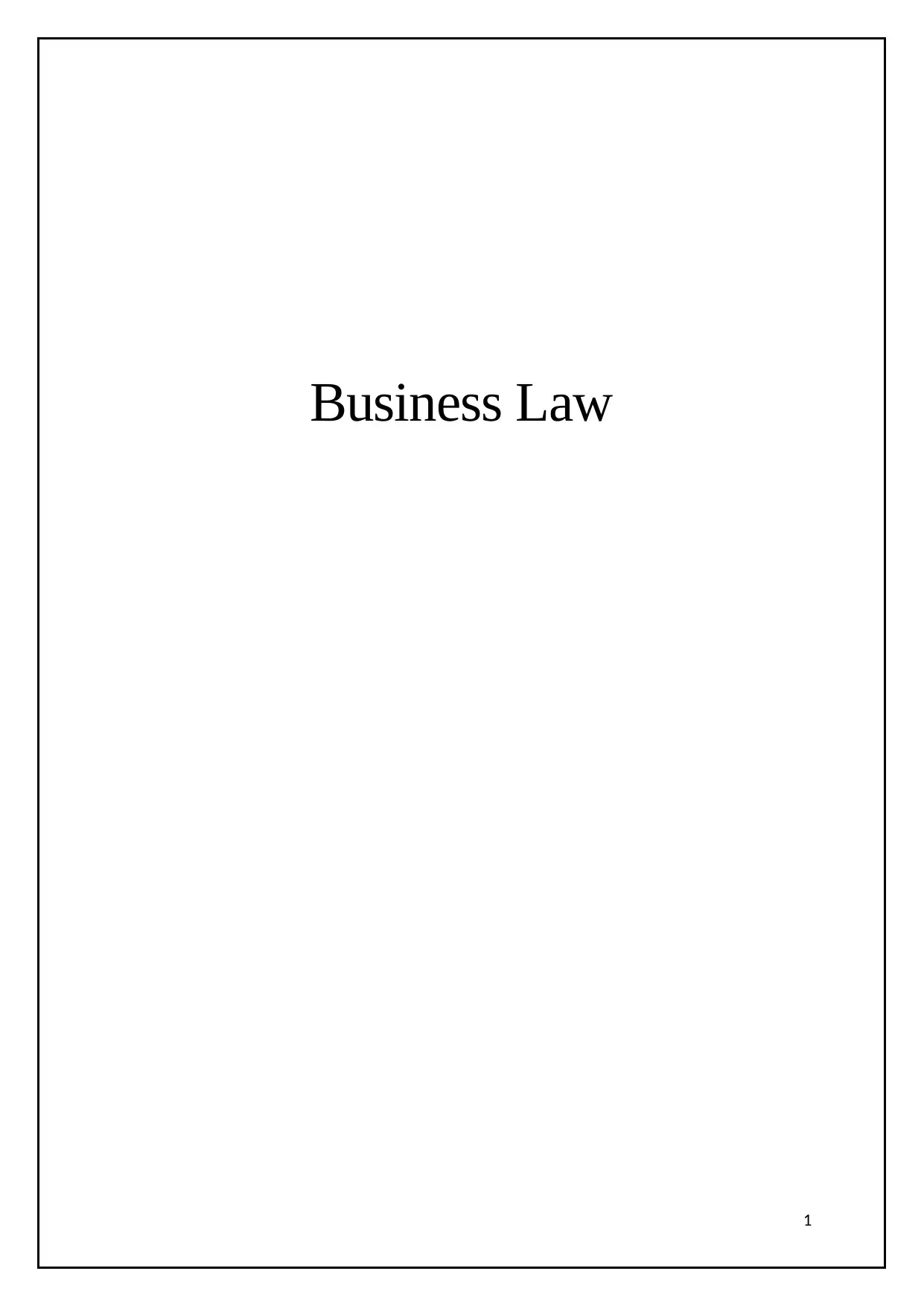
Business Law
1
1
Paraphrase This Document
Need a fresh take? Get an instant paraphrase of this document with our AI Paraphraser
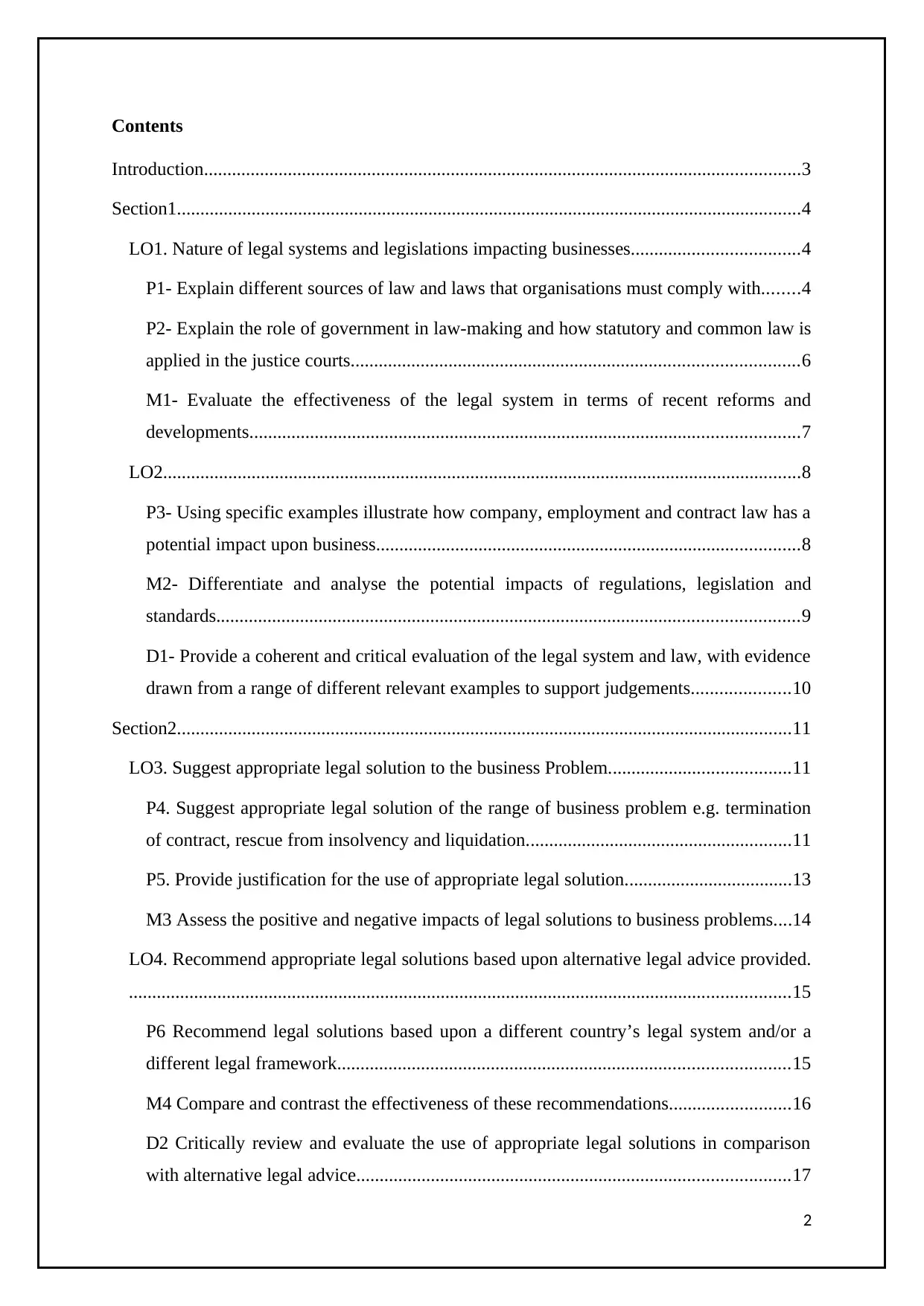
Contents
Introduction................................................................................................................................3
Section1......................................................................................................................................4
LO1. Nature of legal systems and legislations impacting businesses....................................4
P1- Explain different sources of law and laws that organisations must comply with........4
P2- Explain the role of government in law-making and how statutory and common law is
applied in the justice courts................................................................................................6
M1- Evaluate the effectiveness of the legal system in terms of recent reforms and
developments......................................................................................................................7
LO2.........................................................................................................................................8
P3- Using specific examples illustrate how company, employment and contract law has a
potential impact upon business...........................................................................................8
M2- Differentiate and analyse the potential impacts of regulations, legislation and
standards.............................................................................................................................9
D1- Provide a coherent and critical evaluation of the legal system and law, with evidence
drawn from a range of different relevant examples to support judgements.....................10
Section2....................................................................................................................................11
LO3. Suggest appropriate legal solution to the business Problem.......................................11
P4. Suggest appropriate legal solution of the range of business problem e.g. termination
of contract, rescue from insolvency and liquidation.........................................................11
P5. Provide justification for the use of appropriate legal solution....................................13
M3 Assess the positive and negative impacts of legal solutions to business problems....14
LO4. Recommend appropriate legal solutions based upon alternative legal advice provided.
..............................................................................................................................................15
P6 Recommend legal solutions based upon a different country’s legal system and/or a
different legal framework.................................................................................................15
M4 Compare and contrast the effectiveness of these recommendations..........................16
D2 Critically review and evaluate the use of appropriate legal solutions in comparison
with alternative legal advice.............................................................................................17
2
Introduction................................................................................................................................3
Section1......................................................................................................................................4
LO1. Nature of legal systems and legislations impacting businesses....................................4
P1- Explain different sources of law and laws that organisations must comply with........4
P2- Explain the role of government in law-making and how statutory and common law is
applied in the justice courts................................................................................................6
M1- Evaluate the effectiveness of the legal system in terms of recent reforms and
developments......................................................................................................................7
LO2.........................................................................................................................................8
P3- Using specific examples illustrate how company, employment and contract law has a
potential impact upon business...........................................................................................8
M2- Differentiate and analyse the potential impacts of regulations, legislation and
standards.............................................................................................................................9
D1- Provide a coherent and critical evaluation of the legal system and law, with evidence
drawn from a range of different relevant examples to support judgements.....................10
Section2....................................................................................................................................11
LO3. Suggest appropriate legal solution to the business Problem.......................................11
P4. Suggest appropriate legal solution of the range of business problem e.g. termination
of contract, rescue from insolvency and liquidation.........................................................11
P5. Provide justification for the use of appropriate legal solution....................................13
M3 Assess the positive and negative impacts of legal solutions to business problems....14
LO4. Recommend appropriate legal solutions based upon alternative legal advice provided.
..............................................................................................................................................15
P6 Recommend legal solutions based upon a different country’s legal system and/or a
different legal framework.................................................................................................15
M4 Compare and contrast the effectiveness of these recommendations..........................16
D2 Critically review and evaluate the use of appropriate legal solutions in comparison
with alternative legal advice.............................................................................................17
2
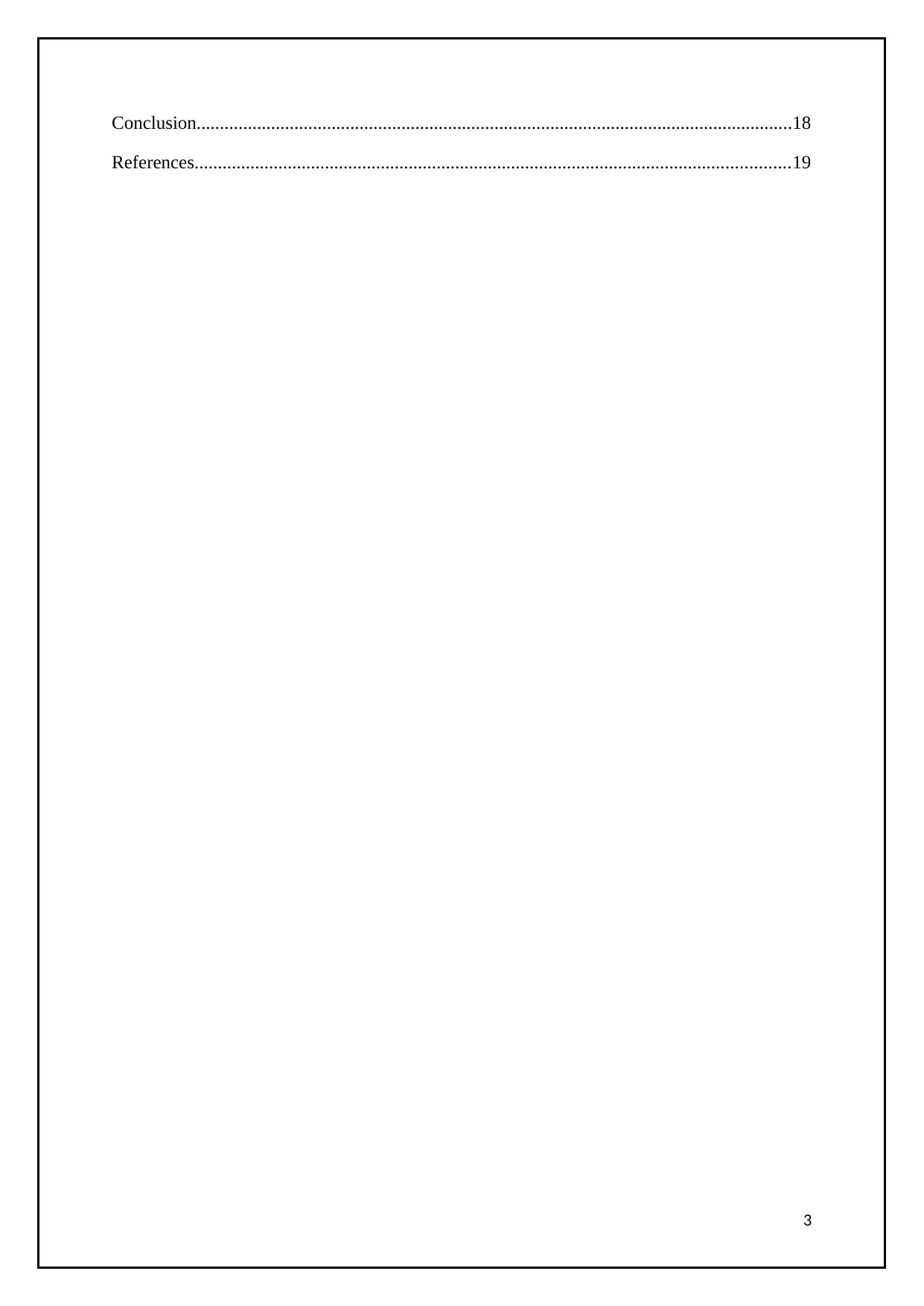
Conclusion................................................................................................................................18
References................................................................................................................................19
3
References................................................................................................................................19
3
⊘ This is a preview!⊘
Do you want full access?
Subscribe today to unlock all pages.

Trusted by 1+ million students worldwide
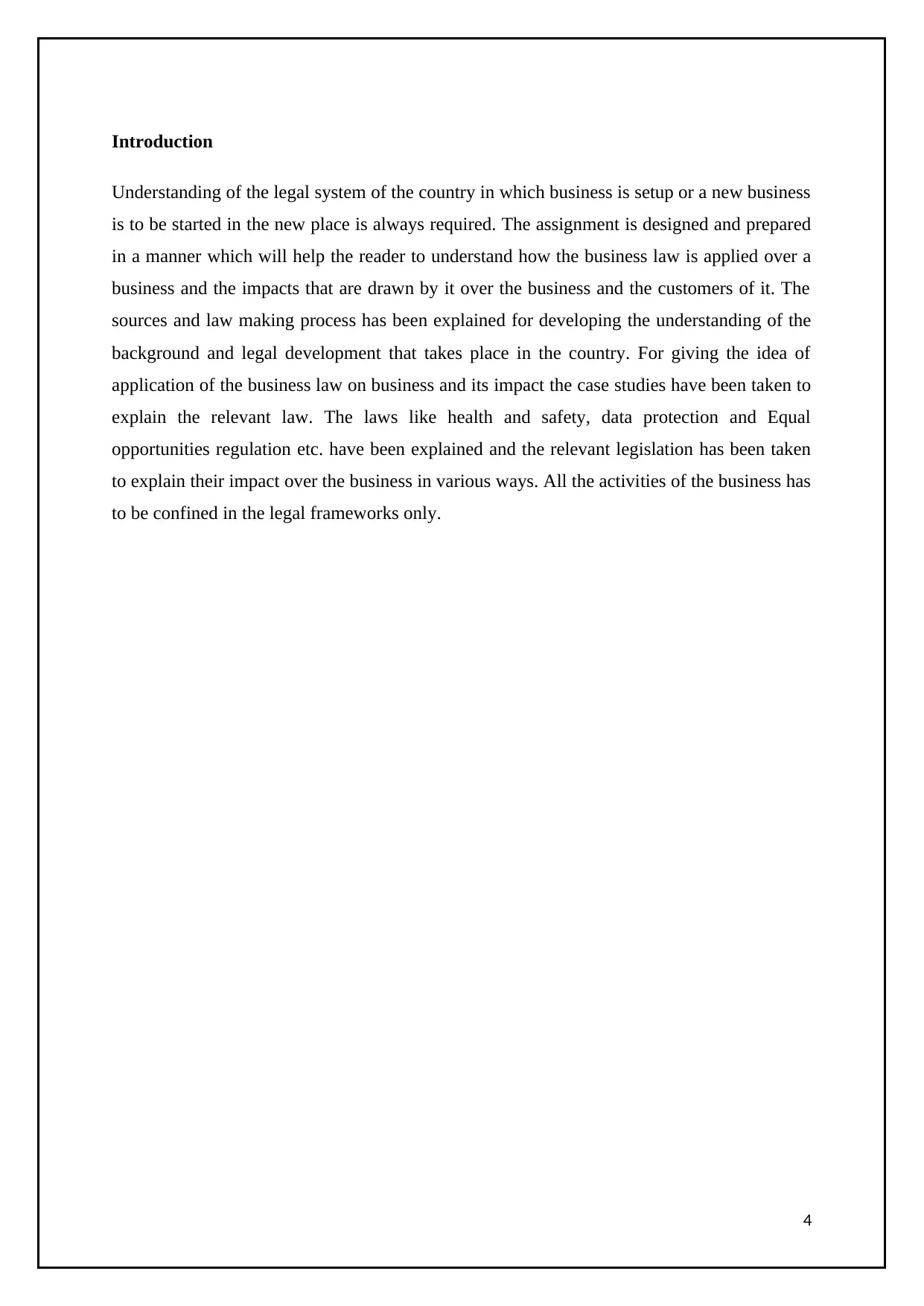
Introduction
Understanding of the legal system of the country in which business is setup or a new business
is to be started in the new place is always required. The assignment is designed and prepared
in a manner which will help the reader to understand how the business law is applied over a
business and the impacts that are drawn by it over the business and the customers of it. The
sources and law making process has been explained for developing the understanding of the
background and legal development that takes place in the country. For giving the idea of
application of the business law on business and its impact the case studies have been taken to
explain the relevant law. The laws like health and safety, data protection and Equal
opportunities regulation etc. have been explained and the relevant legislation has been taken
to explain their impact over the business in various ways. All the activities of the business has
to be confined in the legal frameworks only.
4
Understanding of the legal system of the country in which business is setup or a new business
is to be started in the new place is always required. The assignment is designed and prepared
in a manner which will help the reader to understand how the business law is applied over a
business and the impacts that are drawn by it over the business and the customers of it. The
sources and law making process has been explained for developing the understanding of the
background and legal development that takes place in the country. For giving the idea of
application of the business law on business and its impact the case studies have been taken to
explain the relevant law. The laws like health and safety, data protection and Equal
opportunities regulation etc. have been explained and the relevant legislation has been taken
to explain their impact over the business in various ways. All the activities of the business has
to be confined in the legal frameworks only.
4
Paraphrase This Document
Need a fresh take? Get an instant paraphrase of this document with our AI Paraphraser
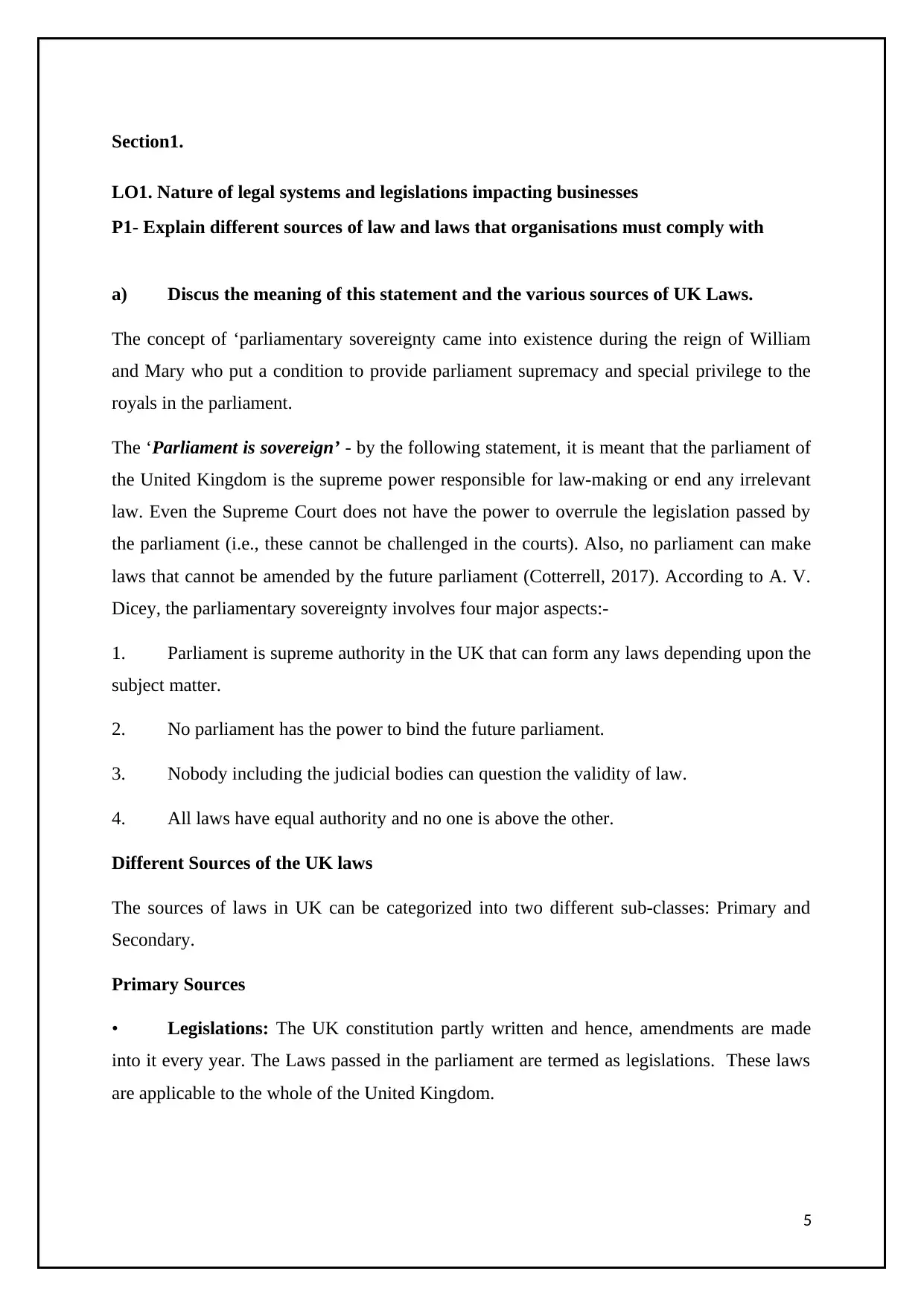
Section1.
LO1. Nature of legal systems and legislations impacting businesses
P1- Explain different sources of law and laws that organisations must comply with
a) Discus the meaning of this statement and the various sources of UK Laws.
The concept of ‘parliamentary sovereignty came into existence during the reign of William
and Mary who put a condition to provide parliament supremacy and special privilege to the
royals in the parliament.
The ‘Parliament is sovereign’ - by the following statement, it is meant that the parliament of
the United Kingdom is the supreme power responsible for law-making or end any irrelevant
law. Even the Supreme Court does not have the power to overrule the legislation passed by
the parliament (i.e., these cannot be challenged in the courts). Also, no parliament can make
laws that cannot be amended by the future parliament (Cotterrell, 2017). According to A. V.
Dicey, the parliamentary sovereignty involves four major aspects:-
1. Parliament is supreme authority in the UK that can form any laws depending upon the
subject matter.
2. No parliament has the power to bind the future parliament.
3. Nobody including the judicial bodies can question the validity of law.
4. All laws have equal authority and no one is above the other.
Different Sources of the UK laws
The sources of laws in UK can be categorized into two different sub-classes: Primary and
Secondary.
Primary Sources
• Legislations: The UK constitution partly written and hence, amendments are made
into it every year. The Laws passed in the parliament are termed as legislations. These laws
are applicable to the whole of the United Kingdom.
5
LO1. Nature of legal systems and legislations impacting businesses
P1- Explain different sources of law and laws that organisations must comply with
a) Discus the meaning of this statement and the various sources of UK Laws.
The concept of ‘parliamentary sovereignty came into existence during the reign of William
and Mary who put a condition to provide parliament supremacy and special privilege to the
royals in the parliament.
The ‘Parliament is sovereign’ - by the following statement, it is meant that the parliament of
the United Kingdom is the supreme power responsible for law-making or end any irrelevant
law. Even the Supreme Court does not have the power to overrule the legislation passed by
the parliament (i.e., these cannot be challenged in the courts). Also, no parliament can make
laws that cannot be amended by the future parliament (Cotterrell, 2017). According to A. V.
Dicey, the parliamentary sovereignty involves four major aspects:-
1. Parliament is supreme authority in the UK that can form any laws depending upon the
subject matter.
2. No parliament has the power to bind the future parliament.
3. Nobody including the judicial bodies can question the validity of law.
4. All laws have equal authority and no one is above the other.
Different Sources of the UK laws
The sources of laws in UK can be categorized into two different sub-classes: Primary and
Secondary.
Primary Sources
• Legislations: The UK constitution partly written and hence, amendments are made
into it every year. The Laws passed in the parliament are termed as legislations. These laws
are applicable to the whole of the United Kingdom.
5
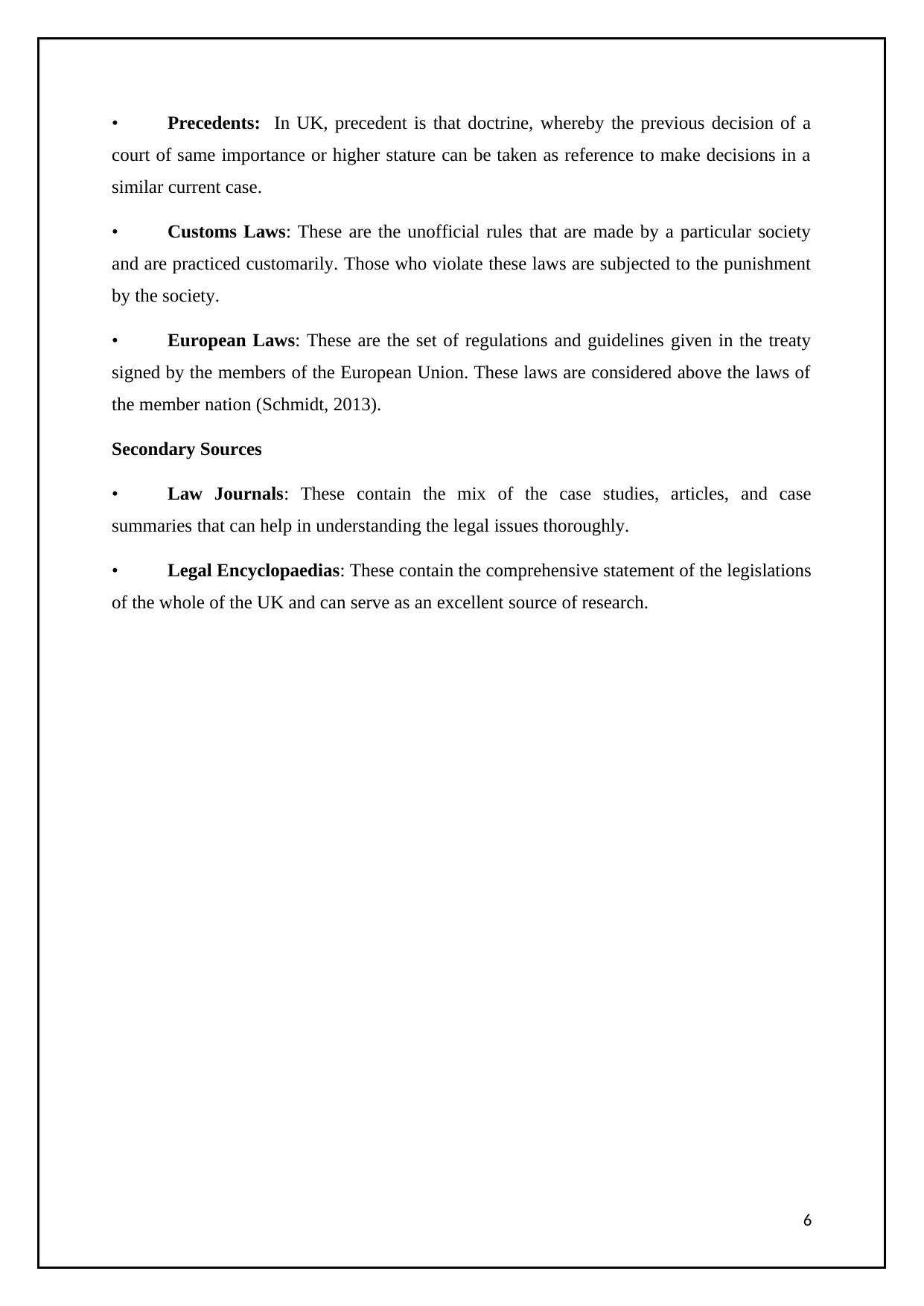
• Precedents: In UK, precedent is that doctrine, whereby the previous decision of a
court of same importance or higher stature can be taken as reference to make decisions in a
similar current case.
• Customs Laws: These are the unofficial rules that are made by a particular society
and are practiced customarily. Those who violate these laws are subjected to the punishment
by the society.
• European Laws: These are the set of regulations and guidelines given in the treaty
signed by the members of the European Union. These laws are considered above the laws of
the member nation (Schmidt, 2013).
Secondary Sources
• Law Journals: These contain the mix of the case studies, articles, and case
summaries that can help in understanding the legal issues thoroughly.
• Legal Encyclopaedias: These contain the comprehensive statement of the legislations
of the whole of the UK and can serve as an excellent source of research.
6
court of same importance or higher stature can be taken as reference to make decisions in a
similar current case.
• Customs Laws: These are the unofficial rules that are made by a particular society
and are practiced customarily. Those who violate these laws are subjected to the punishment
by the society.
• European Laws: These are the set of regulations and guidelines given in the treaty
signed by the members of the European Union. These laws are considered above the laws of
the member nation (Schmidt, 2013).
Secondary Sources
• Law Journals: These contain the mix of the case studies, articles, and case
summaries that can help in understanding the legal issues thoroughly.
• Legal Encyclopaedias: These contain the comprehensive statement of the legislations
of the whole of the UK and can serve as an excellent source of research.
6
⊘ This is a preview!⊘
Do you want full access?
Subscribe today to unlock all pages.

Trusted by 1+ million students worldwide

7
Paraphrase This Document
Need a fresh take? Get an instant paraphrase of this document with our AI Paraphraser
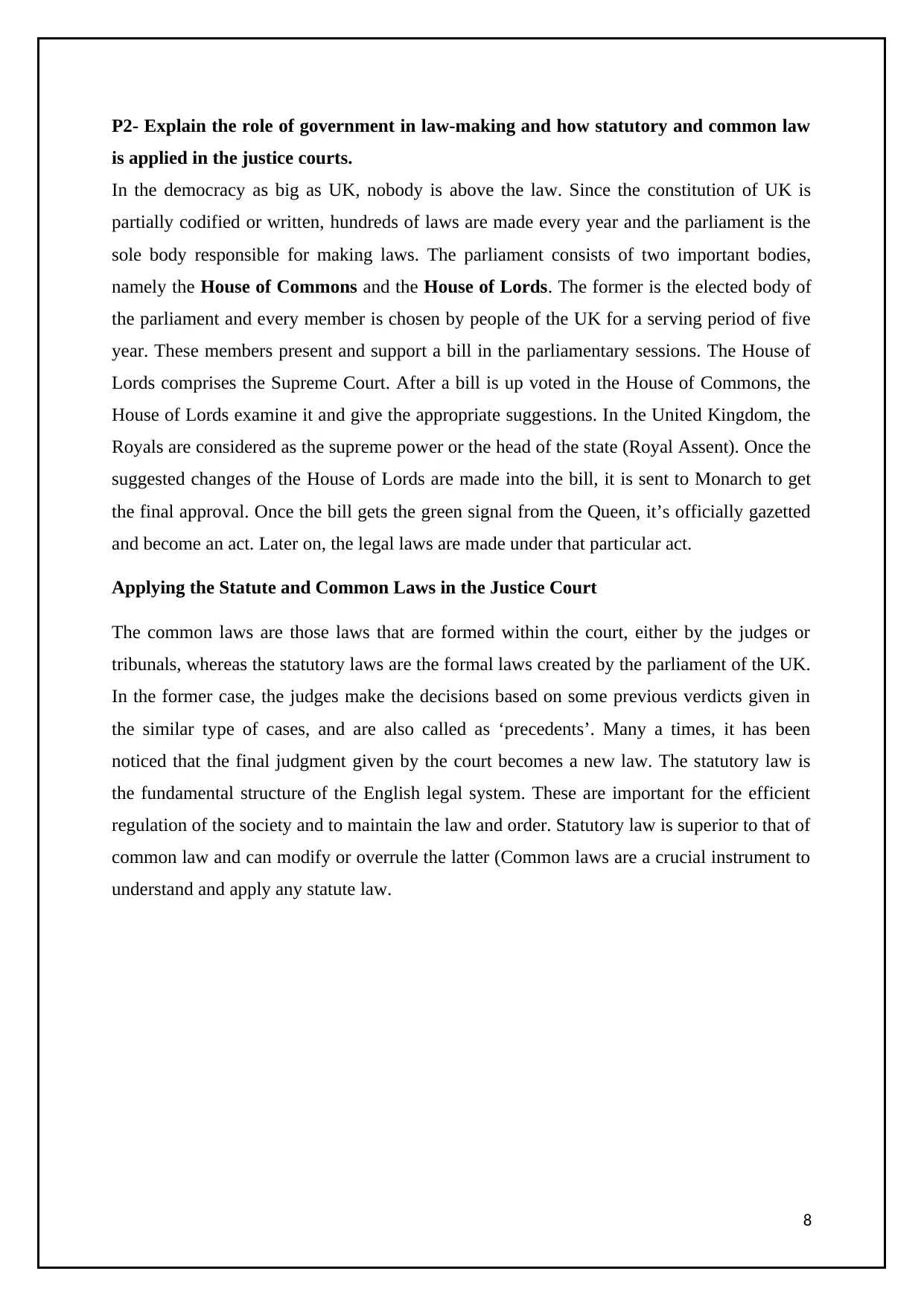
P2- Explain the role of government in law-making and how statutory and common law
is applied in the justice courts.
In the democracy as big as UK, nobody is above the law. Since the constitution of UK is
partially codified or written, hundreds of laws are made every year and the parliament is the
sole body responsible for making laws. The parliament consists of two important bodies,
namely the House of Commons and the House of Lords. The former is the elected body of
the parliament and every member is chosen by people of the UK for a serving period of five
year. These members present and support a bill in the parliamentary sessions. The House of
Lords comprises the Supreme Court. After a bill is up voted in the House of Commons, the
House of Lords examine it and give the appropriate suggestions. In the United Kingdom, the
Royals are considered as the supreme power or the head of the state (Royal Assent). Once the
suggested changes of the House of Lords are made into the bill, it is sent to Monarch to get
the final approval. Once the bill gets the green signal from the Queen, it’s officially gazetted
and become an act. Later on, the legal laws are made under that particular act.
Applying the Statute and Common Laws in the Justice Court
The common laws are those laws that are formed within the court, either by the judges or
tribunals, whereas the statutory laws are the formal laws created by the parliament of the UK.
In the former case, the judges make the decisions based on some previous verdicts given in
the similar type of cases, and are also called as ‘precedents’. Many a times, it has been
noticed that the final judgment given by the court becomes a new law. The statutory law is
the fundamental structure of the English legal system. These are important for the efficient
regulation of the society and to maintain the law and order. Statutory law is superior to that of
common law and can modify or overrule the latter (Common laws are a crucial instrument to
understand and apply any statute law.
8
is applied in the justice courts.
In the democracy as big as UK, nobody is above the law. Since the constitution of UK is
partially codified or written, hundreds of laws are made every year and the parliament is the
sole body responsible for making laws. The parliament consists of two important bodies,
namely the House of Commons and the House of Lords. The former is the elected body of
the parliament and every member is chosen by people of the UK for a serving period of five
year. These members present and support a bill in the parliamentary sessions. The House of
Lords comprises the Supreme Court. After a bill is up voted in the House of Commons, the
House of Lords examine it and give the appropriate suggestions. In the United Kingdom, the
Royals are considered as the supreme power or the head of the state (Royal Assent). Once the
suggested changes of the House of Lords are made into the bill, it is sent to Monarch to get
the final approval. Once the bill gets the green signal from the Queen, it’s officially gazetted
and become an act. Later on, the legal laws are made under that particular act.
Applying the Statute and Common Laws in the Justice Court
The common laws are those laws that are formed within the court, either by the judges or
tribunals, whereas the statutory laws are the formal laws created by the parliament of the UK.
In the former case, the judges make the decisions based on some previous verdicts given in
the similar type of cases, and are also called as ‘precedents’. Many a times, it has been
noticed that the final judgment given by the court becomes a new law. The statutory law is
the fundamental structure of the English legal system. These are important for the efficient
regulation of the society and to maintain the law and order. Statutory law is superior to that of
common law and can modify or overrule the latter (Common laws are a crucial instrument to
understand and apply any statute law.
8
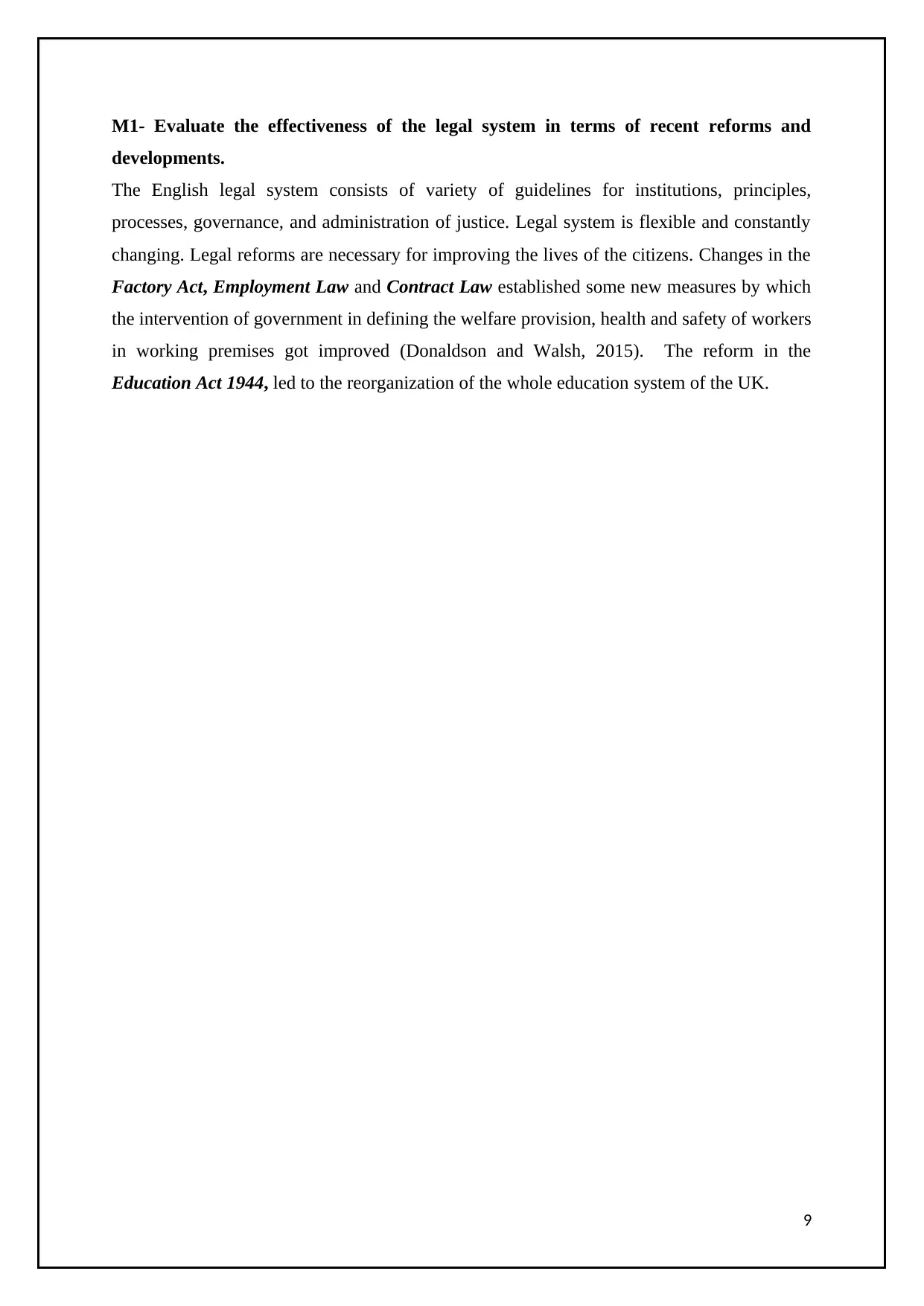
M1- Evaluate the effectiveness of the legal system in terms of recent reforms and
developments.
The English legal system consists of variety of guidelines for institutions, principles,
processes, governance, and administration of justice. Legal system is flexible and constantly
changing. Legal reforms are necessary for improving the lives of the citizens. Changes in the
Factory Act, Employment Law and Contract Law established some new measures by which
the intervention of government in defining the welfare provision, health and safety of workers
in working premises got improved (Donaldson and Walsh, 2015). The reform in the
Education Act 1944, led to the reorganization of the whole education system of the UK.
9
developments.
The English legal system consists of variety of guidelines for institutions, principles,
processes, governance, and administration of justice. Legal system is flexible and constantly
changing. Legal reforms are necessary for improving the lives of the citizens. Changes in the
Factory Act, Employment Law and Contract Law established some new measures by which
the intervention of government in defining the welfare provision, health and safety of workers
in working premises got improved (Donaldson and Walsh, 2015). The reform in the
Education Act 1944, led to the reorganization of the whole education system of the UK.
9
⊘ This is a preview!⊘
Do you want full access?
Subscribe today to unlock all pages.

Trusted by 1+ million students worldwide
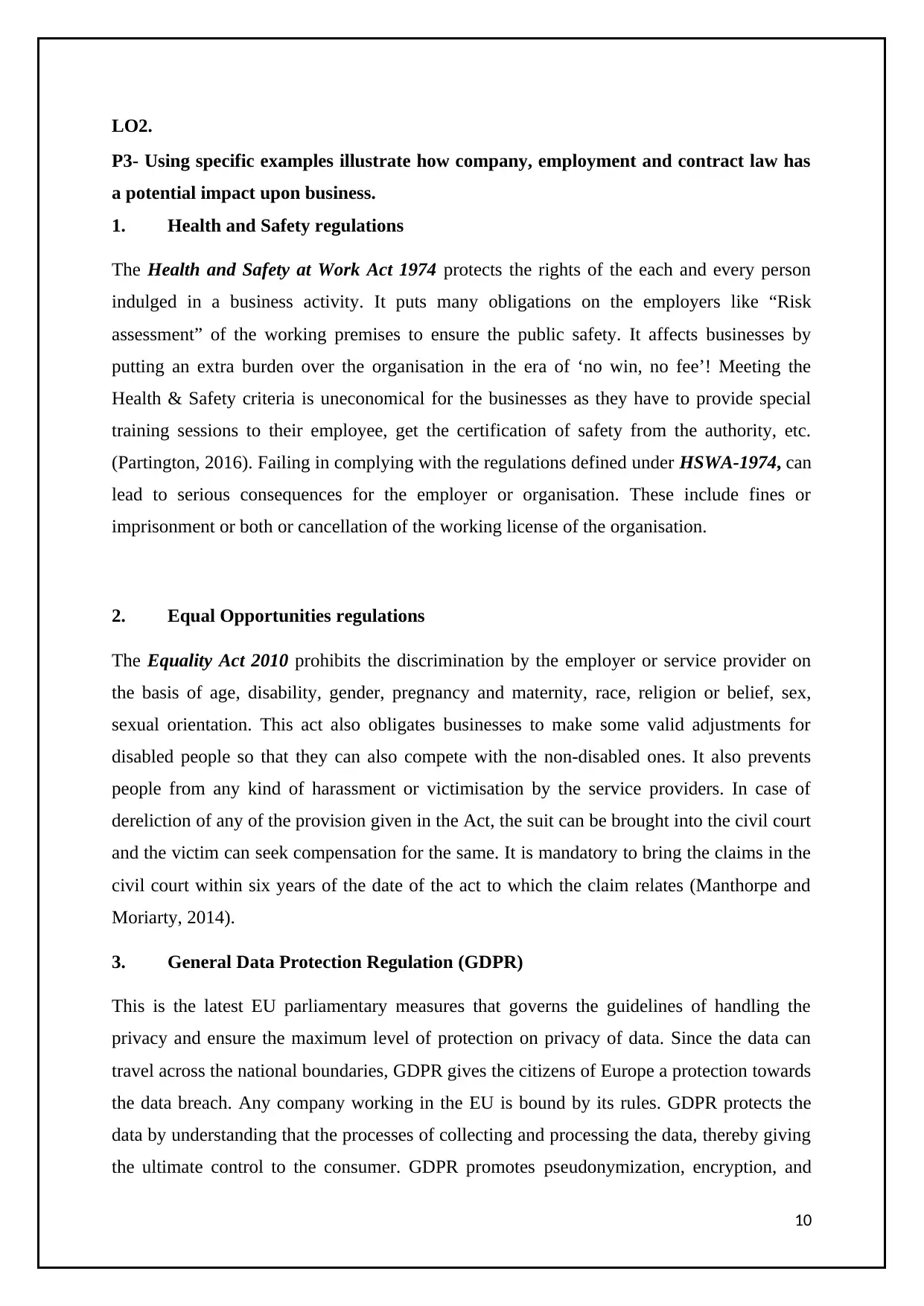
LO2.
P3- Using specific examples illustrate how company, employment and contract law has
a potential impact upon business.
1. Health and Safety regulations
The Health and Safety at Work Act 1974 protects the rights of the each and every person
indulged in a business activity. It puts many obligations on the employers like “Risk
assessment” of the working premises to ensure the public safety. It affects businesses by
putting an extra burden over the organisation in the era of ‘no win, no fee’! Meeting the
Health & Safety criteria is uneconomical for the businesses as they have to provide special
training sessions to their employee, get the certification of safety from the authority, etc.
(Partington, 2016). Failing in complying with the regulations defined under HSWA-1974, can
lead to serious consequences for the employer or organisation. These include fines or
imprisonment or both or cancellation of the working license of the organisation.
2. Equal Opportunities regulations
The Equality Act 2010 prohibits the discrimination by the employer or service provider on
the basis of age, disability, gender, pregnancy and maternity, race, religion or belief, sex,
sexual orientation. This act also obligates businesses to make some valid adjustments for
disabled people so that they can also compete with the non-disabled ones. It also prevents
people from any kind of harassment or victimisation by the service providers. In case of
dereliction of any of the provision given in the Act, the suit can be brought into the civil court
and the victim can seek compensation for the same. It is mandatory to bring the claims in the
civil court within six years of the date of the act to which the claim relates (Manthorpe and
Moriarty, 2014).
3. General Data Protection Regulation (GDPR)
This is the latest EU parliamentary measures that governs the guidelines of handling the
privacy and ensure the maximum level of protection on privacy of data. Since the data can
travel across the national boundaries, GDPR gives the citizens of Europe a protection towards
the data breach. Any company working in the EU is bound by its rules. GDPR protects the
data by understanding that the processes of collecting and processing the data, thereby giving
the ultimate control to the consumer. GDPR promotes pseudonymization, encryption, and
10
P3- Using specific examples illustrate how company, employment and contract law has
a potential impact upon business.
1. Health and Safety regulations
The Health and Safety at Work Act 1974 protects the rights of the each and every person
indulged in a business activity. It puts many obligations on the employers like “Risk
assessment” of the working premises to ensure the public safety. It affects businesses by
putting an extra burden over the organisation in the era of ‘no win, no fee’! Meeting the
Health & Safety criteria is uneconomical for the businesses as they have to provide special
training sessions to their employee, get the certification of safety from the authority, etc.
(Partington, 2016). Failing in complying with the regulations defined under HSWA-1974, can
lead to serious consequences for the employer or organisation. These include fines or
imprisonment or both or cancellation of the working license of the organisation.
2. Equal Opportunities regulations
The Equality Act 2010 prohibits the discrimination by the employer or service provider on
the basis of age, disability, gender, pregnancy and maternity, race, religion or belief, sex,
sexual orientation. This act also obligates businesses to make some valid adjustments for
disabled people so that they can also compete with the non-disabled ones. It also prevents
people from any kind of harassment or victimisation by the service providers. In case of
dereliction of any of the provision given in the Act, the suit can be brought into the civil court
and the victim can seek compensation for the same. It is mandatory to bring the claims in the
civil court within six years of the date of the act to which the claim relates (Manthorpe and
Moriarty, 2014).
3. General Data Protection Regulation (GDPR)
This is the latest EU parliamentary measures that governs the guidelines of handling the
privacy and ensure the maximum level of protection on privacy of data. Since the data can
travel across the national boundaries, GDPR gives the citizens of Europe a protection towards
the data breach. Any company working in the EU is bound by its rules. GDPR protects the
data by understanding that the processes of collecting and processing the data, thereby giving
the ultimate control to the consumer. GDPR promotes pseudonymization, encryption, and
10
Paraphrase This Document
Need a fresh take? Get an instant paraphrase of this document with our AI Paraphraser
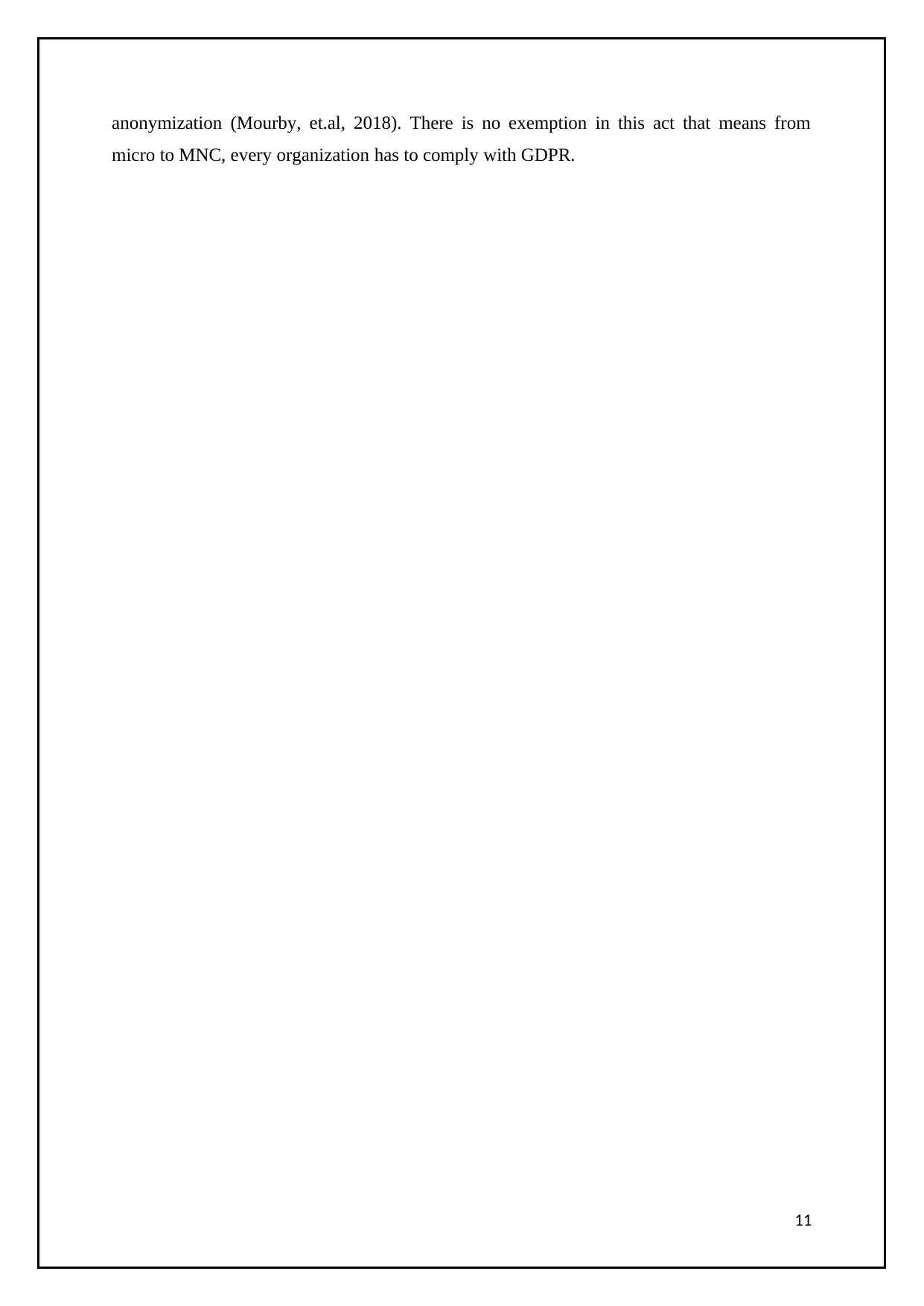
anonymization (Mourby, et.al, 2018). There is no exemption in this act that means from
micro to MNC, every organization has to comply with GDPR.
11
micro to MNC, every organization has to comply with GDPR.
11
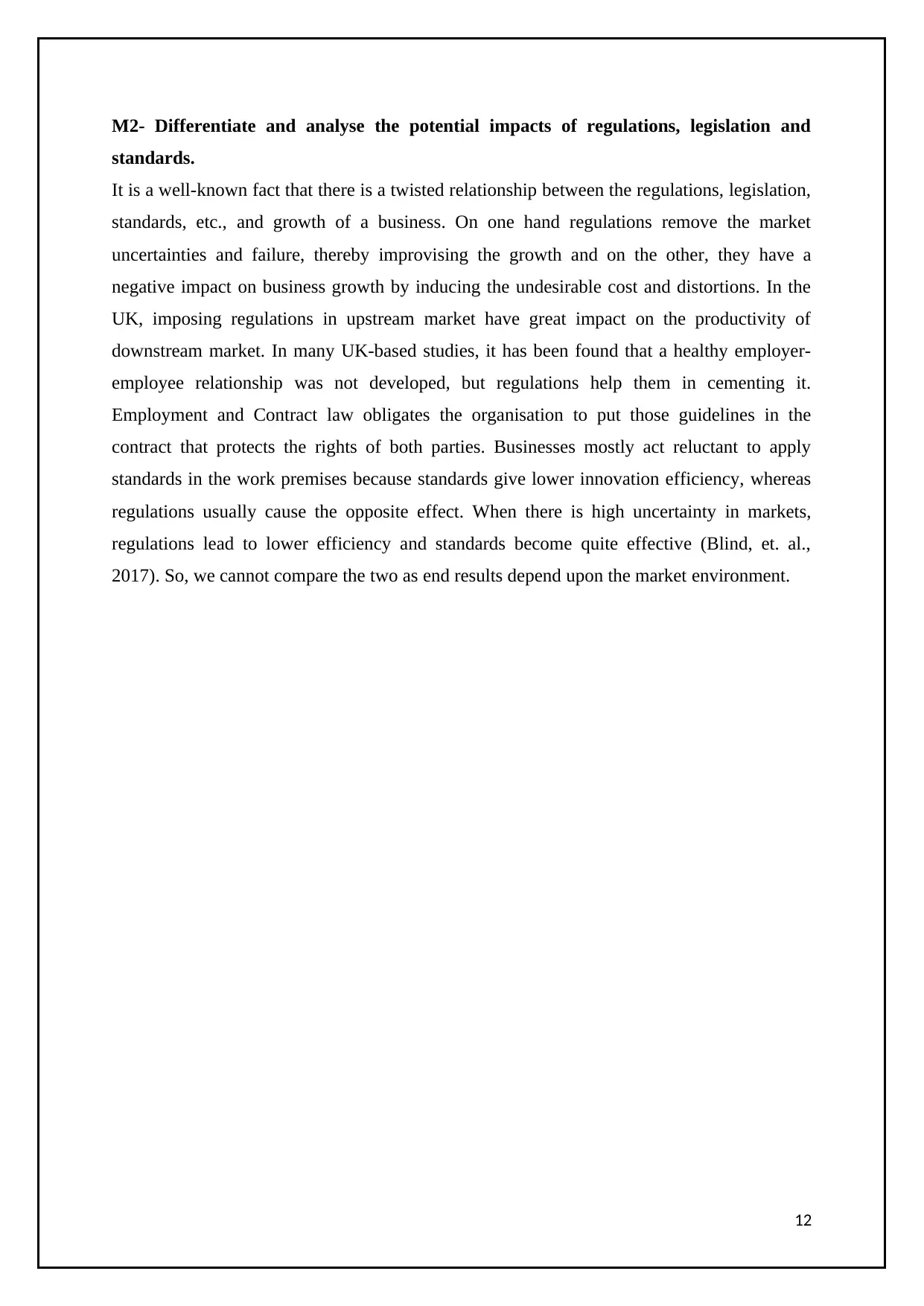
M2- Differentiate and analyse the potential impacts of regulations, legislation and
standards.
It is a well-known fact that there is a twisted relationship between the regulations, legislation,
standards, etc., and growth of a business. On one hand regulations remove the market
uncertainties and failure, thereby improvising the growth and on the other, they have a
negative impact on business growth by inducing the undesirable cost and distortions. In the
UK, imposing regulations in upstream market have great impact on the productivity of
downstream market. In many UK-based studies, it has been found that a healthy employer-
employee relationship was not developed, but regulations help them in cementing it.
Employment and Contract law obligates the organisation to put those guidelines in the
contract that protects the rights of both parties. Businesses mostly act reluctant to apply
standards in the work premises because standards give lower innovation efficiency, whereas
regulations usually cause the opposite effect. When there is high uncertainty in markets,
regulations lead to lower efficiency and standards become quite effective (Blind, et. al.,
2017). So, we cannot compare the two as end results depend upon the market environment.
12
standards.
It is a well-known fact that there is a twisted relationship between the regulations, legislation,
standards, etc., and growth of a business. On one hand regulations remove the market
uncertainties and failure, thereby improvising the growth and on the other, they have a
negative impact on business growth by inducing the undesirable cost and distortions. In the
UK, imposing regulations in upstream market have great impact on the productivity of
downstream market. In many UK-based studies, it has been found that a healthy employer-
employee relationship was not developed, but regulations help them in cementing it.
Employment and Contract law obligates the organisation to put those guidelines in the
contract that protects the rights of both parties. Businesses mostly act reluctant to apply
standards in the work premises because standards give lower innovation efficiency, whereas
regulations usually cause the opposite effect. When there is high uncertainty in markets,
regulations lead to lower efficiency and standards become quite effective (Blind, et. al.,
2017). So, we cannot compare the two as end results depend upon the market environment.
12
⊘ This is a preview!⊘
Do you want full access?
Subscribe today to unlock all pages.

Trusted by 1+ million students worldwide
1 out of 24
Related Documents
Your All-in-One AI-Powered Toolkit for Academic Success.
+13062052269
info@desklib.com
Available 24*7 on WhatsApp / Email
![[object Object]](/_next/static/media/star-bottom.7253800d.svg)
Unlock your academic potential
Copyright © 2020–2025 A2Z Services. All Rights Reserved. Developed and managed by ZUCOL.





